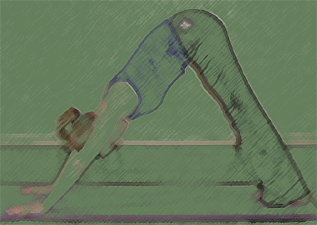
Between yin poses many teachers suggest a bit of yang movement. This feels nice and stimulates the flow of energy in the body before the next posture. Remember, you can do too much of anything. Too much yang leads to exhaustion and depletion – too much yin, however, leads to stagnation. Some yang between the postures helps keep stagnation from developing. Choose whatever yang movements would feel nice: let your body decide or pick something from the list below.
This list is not exhaustive and it is not the intention during this journey to understand yang asanas. You may have to find a teacher to offer you more yang options or more details on the postures suggested.
- Boat – while sitting, extend legs out in front of you and up in the air, holding the back of the legs, or for more challenge, extend the arms forward.
- Cat’s breath – flowing from Upward Facing Cat to Downward Facing Cat.
- Crocodile – like a push-up but on elbows/forearms and held for a minute or less.
- Down dog and all its variations
- Eye-of-the-needle – lie on your back with knees bent. Place the right ankle on the left knee. Reach the right hand through the triangular “window” formed by right leg and clasp the left hand on the top of the left knee (or underneath the knee if on top is not achievable). Pull the knee and ankle toward your left shoulder until you feel the stretch in the right hip. Remember to do both sides.
- Fish – but make it a gentle fish, sometimes done with legs in butterfly. Place your straight arms under your back as you lie down; hands can be right under the buttocks and elbows as close together as possible. Bend the elbows as you lift your chest. Relax the top of your head to the floor and rest on it gently.
- Hinge – while lying on your back, raise and lower the legs; knees bent is easiest, straight legs is harder. To support the back, place your hands, with palms down, under your buttocks.
- Lie on your back and hug the knees to the chest and rock from side to side.
- Locusts (aka Infant) – lie on your stomach and lift your arms, chest and legs up.
- Plank – full push-ups or hover above the floor in Chaturanga. For Chaturanga do the full push-up but lower a few inches toward the floor. Make sure you don’t sink into the shoulders or let your hips sag. Your shoulders should not be lower than your elbows. You should be able to see your toes!
- Sun Salutations (recommended only at the end of a practice and done for at least ten minutes).
- Tabletop (also known as Hammock) or Slide – with hands behind you on the floor, lift your hips up. Feet can be on the floor with legs bent or legs straight (having the legs straight turns this into the Slide). Flow into this one by raising hips and lowering hips with the breath (up on inhale/down on exhale). After three or four cycles, hold the position for three or four breaths.
- Windshield wipers – sit with hands behind you on the floor and feet apart, drop knees from side to side. Can be done lying down too.
Sarah Powers and Paul Grilley have many excellent yang exercises you can choose from; check out their DVDs or Paul’s book for more suggestions.
Yang movements between yin postures should be brief. If each style is performed for a long period (say over five minutes), the body can be confused by the constant shifting from yin mode to yang mode. If you want to include a lot of yang postures during a yin practice, group the yang asanas into a large segment of time. Allow at least fifteen minutes of constant yang practice or at least fifteen minutes of yin practice to unfold at the same time. Do not keep switching back and forth more quickly than that. Keep the yang counterposes brief between the yin postures.
(Next: Flowing )
